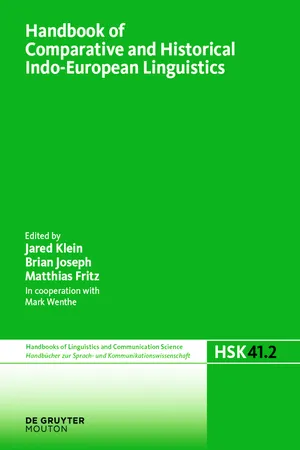
eBook - ePub
Handbook of Comparative and Historical Indo-European Linguistics
This is a test
- 672 pages
- English
- ePUB (mobile friendly)
- Available on iOS & Android
eBook - ePub
Handbook of Comparative and Historical Indo-European Linguistics
Book details
Book preview
Table of contents
Citations
About This Book
This book presents the most comprehensive coverage of the field of Indo-European Linguistics in a century, focusing on the entire Indo-European family and treating each major branch and most minor languages. The collaborative work of 120 scholars from 22 countries, Handbook of Comparative and Historical Indo-European Linguistics combines the exhaustive coverage of an encyclopedia with the in-depth treatment of individual monographic studies.
Frequently asked questions
At the moment all of our mobile-responsive ePub books are available to download via the app. Most of our PDFs are also available to download and we're working on making the final remaining ones downloadable now. Learn more here.
Both plans give you full access to the library and all of Perlego’s features. The only differences are the price and subscription period: With the annual plan you’ll save around 30% compared to 12 months on the monthly plan.
We are an online textbook subscription service, where you can get access to an entire online library for less than the price of a single book per month. With over 1 million books across 1000+ topics, we’ve got you covered! Learn more here.
Look out for the read-aloud symbol on your next book to see if you can listen to it. The read-aloud tool reads text aloud for you, highlighting the text as it is being read. You can pause it, speed it up and slow it down. Learn more here.
Yes, you can access Handbook of Comparative and Historical Indo-European Linguistics by Jared Klein, Brian Joseph, Matthias Fritz, Mark Wenthe, Jared Klein, Brian Joseph, Matthias Fritz in PDF and/or ePUB format, as well as other popular books in Languages & Linguistics & Linguistics. We have over one million books available in our catalogue for you to explore.
Information
X. Armenian
60. The documentation of Armenian
1. Introduction
2. The early period (5th−11th centuries)
3. The middle period (12th−16th centuries)
4. The modern period (17th−21st centuries)
5. References
1. Introduction
Historical Armenia is a large plateau roughly bounded by the Caucasus Mountains, the Black and the Caspian Seas, Iran and Mesopotamia. The highest mountain is Mount Ararat, and the country has three major lakes: Urmia, Van, and Sevan. The most important river is the Araxes.
There are different theories about the origin of the Armenian people. The scholars who consider the steppes in the Southern part of Russia to be the homeland of the Indo-Europeans suppose that the Armenians arrived in their country from the Balkan Peninsula, probably during the second millennium BCE. However, according to other scholars, e.g. Thomas V. Gamkrelidze and Vjačeslav V. Ivanov, the Indo-European homeland roughly coincided with historical Armenia, so the Armenians were just the descendants of the Indo-European tribes settled in this area. A considerably different opinion is held by Mario Alinei. According to his “Paleolithic Continuity Theory”, no Indo-European invasion took place and the Indo-European languages spoken in Europe including, as we can guess, also Armenian, just continue the languages of the inhabitants of the Paleolithic period.
The history of the Armenian language can be divided into three main periods. For further information on this history see Ačar̄yan (1951); Nichanian (1989); Łazarean (2007). Discussion of toponomastic and anthroponymic issues is beyond our immediate concern.
2. The early period (5th−11th centuries)
2.1. We know nearly nothing about the Armenian language before the 5th century CE, when the Armenian script was invented by Maštocʿ, a clergyman also called Mesrop in supposedly later sources. Around 387 CE, Armenia was divided between the Byzantine and the Sasanian states. The part under Byzantine influence was soon annexed by the empire, while the other maintained a sort of independence until 428. The most enlightened persons of the 5th century, such as the patriarch Sahak, Maštocʿ, and King Vrāmšapowh, were well aware that, with the loss of political independence, the existence of the Armenian ethnos was also threatened. The country had been officially Christianized in the early 4th century (the traditional date is 301), but the Armenian approach to Christianity was not fully acceptable to the Byzantines, whereas the Persians suspected that the Armenians, as a Christian people, certainly were in tacit agreement with the Western enemy. Thus, the commitment of the Armenian language to writing was first of all necessary for survival and, furthermore, for religious purposes, in order to facilitate the preaching of the Chris...
Table of contents
- Cover
- Title
- Copyright
- Contents
- VIII. Italic
- IX. Germanic
- X. Armenian
- XI. Celtic
- XII. Tocharian